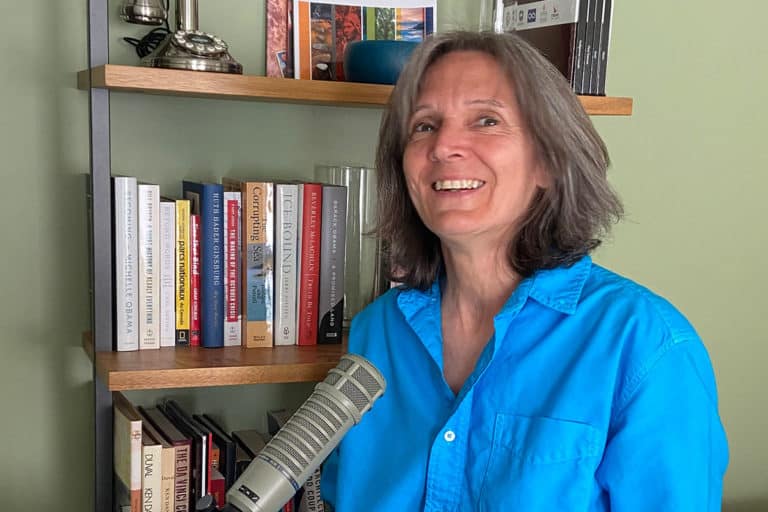Stress and conflict play havoc in your body. Clear thinking becomes muddled; facts get washed away in a sea of emotions. Locate, Describe & Transform™ can help.
Key Points To Transform Stress and Conflict
Do you think the tension in your neck is caused by your worry? Or that your stomach knot is a direct result of your fear? It’s actually a much simpler, and more powerful connection. The tension and knot are your emotions. There is no cause and effect.
If you walk away knowing only three things, know this:
1. Your Emotions Are Embodied
Emotions are reactions in your body, they don’t happen to your body. Put another way, your emotions don’t cause your body’s reactions. They are your body’s reactions. This is good news! Without the complications of cause and effect, you can work with a simple process to transform your negative emotions.
2. Metaphor is Your Friend
You naturally describe your emotions with metaphor. Don’t spiral into dreaded memories of English classes and definitions! Trust your intuition. Look to the words you already use, because more often than not, your metaphors simply pop into your mind. (Stomach knot, spiral, and pop are a few simple examples.)
It works the same if you are more focused on images than words. The dreams you have, and the scenes that come to your mind – straightforward or extravagantly detailed – all describe your emotions.
3. You Already Know How to Paint
If you paint a different picture – that is, transform your metaphor or scene – you simultaneously transform your emotions. For the stomach knot metaphor, imagine unravelling your knot(s). Then burn the rope, twine, or thread (what does it look like to you?) so it can’t get you knotted up again.
Are you breathing easier? If so, it’s time to ask yourself what your best next step is, or what you really think of the person or situation. With your fear, anger, or other negative emotions transformed – even if only for the moment – you will make your best decision in this moment.
If you saw a scene but didn’t get any words, look to its parts. What draws you in the most? Does your scene include, for example, a spiral staircase that makes it more difficult to climb the ladder to success? Imagine instead a straightforward staircase, wide, stable, and inviting. Does the spiral staircase feel mostly positive but not quite right? Clean it up, or open the curtains to let its beauty shine.
Stress and Conflict Does Not Look The Same To Everyone
While it may seem obvious as I state it now, each person involved in the same conflict will come up with a different metaphor, or imagine a different scene.
- you may have stomach knots, while someone else feels like they are sinking in quicksand
Or perhaps you both feel like you are sinking in quicksand, but:
- your quicksand is ankle deep, and you are standing at the edge
- the other person is in the middle and up to their waist
There is no doubt that waist-high and stuck in the middle represent much stronger emotions. So the next time you are in conflict with someone, be careful of your assumptions. You may be using the same language, but painting very different pictures, and feeling very different emotions.
No More Reactivity
You cannot get rid of your emotions, nor would it be good if you could. Emotions can guide you to make your best decisions, or even to make a simple decision when all else is equal. But there is a difference between emotions that lead you to healthy action (even if your action creates more conflict), and those causing reactive decision-making.
You now have the basics to start transforming the emotions that make you reactive when faced with stress and conflict. But if you like more structure, here is a simple, 3-step process – supported by research – that you can rely on.
LDT™: A Simple 3-Step Process
Your head wants you to think your way through the stress or conflict. Your heart insists you must feel your way through. Both are correct, but they need to be healthily balanced. And balance can be very dependent on the situation.
So how can you adjust on the fly, and bridge the gap between your intellect and your emotions?
In brief, LDT™: Locate, Describe, & Transform.
- Locate the stress or tension in your body.
- Describe it in as much detail as you can or wish.
- Transform the description, metaphor, or image into something lighter or more positive.
What Is Your Body Telling You?
LDT™ grew out of the concepts outlined above. But let’s get away from theory and research, and put it to the test.
I’m going to share two childhood stories of stress and conflict. In the first story, I was about ten years old; I was fifteen in the second story. Both instances shaped how I grew to deal with conflict, even as the stories themselves were long forgotten.
As I researched my master’s thesis in 2007, I tried to recall conflict stories from my past. (My degree was in dispute resolution and explored LDT™.) Events I had no longer remembered came back to me. I forgot them once again as soon as my thesis was complete.
It is only in re-reading my thesis for this post that I remembered the events once more. My own emotions have long since been (repeatedly!) transformed. If I hadn’t written the stories down, I would be hard-pressed to remember the events at all.
So as you read or listen, notice my metaphors (italics), but don’t try to imagine what you think I was/am feeling. Instead, pay attention to your body, because that’s where your own emotions play out. Notice, too, the images that spring to your mind as you take in my words.
When you have finished my story, try using LDT™ to Locate, Describe, & Transform any negative emotions you may be experiencing. Do this even if what you are feeling is bored to tears, or you find yourself rolling your eyes. Ultimately, it is your emotions you want to learn about, whatever they are.
Stress and Conflict: Once Upon A Time...
I was raised in tension and conflict. It wasn’t always loud, and most often wasn’t directed at me, but it permeated my being and taught me how to be in relationship. I learned when to be silent and slip out unseen, and when to apologize despite not having done anything wrong. I became an expert at hiding my feelings with sarcasm, and lashing out, either with words or fists, in what I believed was self-defence.
In The Doghouse
It’s funny what remains in our memory, and how that memory shapes us, sometimes unknowingly. When I was about ten years old, my parents bought The Family Doghouse plaque. We all giggled and thought it was cute. I didn’t think that way for long.
Imagine a plaque about four inches high and ten inches long. On the left was a little dog house with a hook inside. The rest of the plaque contained five hooks, each with a little dog figure, and each dog labelled with the name of someone in the house. When somebody was ‘bad’ their dog was put in the doghouse, to be removed only when they were ‘good’ again.
What certainly started as a joke became a model for ridicule and sibling taunts as it was used in real-life situations. Despite its very short life span, this plaque explicitly set up what was already a developing implicit message: Whoever had ‘done wrong’ was fair game for any of the siblings to pick on.
It was then that I became aware of how I didn’t fit in with my family’s version of conflict management.
Frustration Boiling Over
At fifteen years old, I began a conscious move away from conflict as a way of life. It was a Friday after school, and my siblings and I were to have the house cleaned before my mum came home from work. It had been one of those weeks where my mother had decided that I was in the metaphoric doghouse. I had no idea what I may have done.
The plaque no longer existed. I’m certain my younger siblings didn’t even remember it. But we had all internalized the message, and I had endured a week of sarcasm and nastiness from my older sister and two younger brothers. This day was no different, and at some point my frustration boiled over, and I started screaming uncontrollably.
I did not think – I knew – that I could kill the brother who was provoking me. I never felt anything like it before, nor have I since. Something inside me gained enough control to place myself on one side of the kitchen table while I screamed at my sister to get him out of the room. Another voice inside my head reasoned that I didn’t want to go to jail, and after some minutes, I calmed down.
I promised myself that I would not live in violence, and spent the rest of my teenage years doing my best to suppress the anger that had spilled over that day.
Stress and Conflict Management Is NOT The Same As Transformation
The language here is important. I didn’t learn to release my anger and hurt in a healthy way. I simply learned how to not let it manifest against somebody else in a physical or purposefully hurtful manner. This was an effective conflict management technique given my environment, my lack of role models, and my desire to act more positively than I had been taught. However, it couldn’t last if I was to develop healthy relationships, including, most importantly, a healthy relationship with myself.
In my mid-twenties, I began the slow road to change. And in my early thirties, single parent to a young daughter, I found myself in a counsellor’s office. I was committed to doing whatever was necessary to not re-create negative patterns with my own child.
Coping Against The Pressures In An Unrelenting World
My life was not extraordinary in the amount of conflict I lived with. I believed then, and do now, that my childhood was no different from many of the kids around me. We were another ‘normal’ family struggling to cope against the pressures of what was perceived by my parents as an unrelenting world.
They had not been taught how to be healthy in relationship and did not have the skill set to pass healthy behaviours on to their kids. Their experiences became ours, and ours blended with the rest of society’s: individual faces representing the social problems of bullying, child abuse, alcoholism, poverty, crime, divorce, workplace stress, and the traumas of war.
Breaking the Cycle
As the cycle of negativity grows and expands, individual conflict becomes group conflict. To heal the group, we must first heal ourselves. Pioneering therapist Virginia Satir said “the family is a microcosm. By knowing how to heal the family, I know how to heal the world.” And, as Satir also acknowledged, healing the family starts with the individual.
After about a year, I had benefited as much as I could from traditional counselling. But what could help me stay on course? Despite having always dismissed the idea of “new age” intuitive healing, I found myself exploring a day-to-day self-healing process.
LDT™: Moving From Intuitive Practice to Academic Support
I pulled the above content directly from the introduction in my master’s degree thesis in dispute resolution (University of Victoria, British Columbia, 2008). While I had initially focused on human rights, I took a detour.
As part of my research, I found myself guided to define and formalize the process I had been using intuitively, in hopes of better explaining it to others. Three words presented themselves to me – Locate, Describe, & Transform – along with the acronym LDT™. Let’s take a closer look.
- Locate: Begin by noticing the area of your body where the negative emotion is playing out. Where do you feel tension or discomfort? This step can also help you identify your metaphor, such as: stomach knot, knee-deep in quicksand, and shouldering the weight.
- Describe: Once you know where to look, ask yourself what phrase or scene comes to mind. Then describe the scene in as much detail as you can or wish. The key is to trust your intuition and don’t overthink or look for logic! The scenes represent your emotions, not your thoughts. And emotions, even if appropriate given the circumstances, aren’t logical.
- Transform: Once you have described your scene, imagine transforming it into something more positive. Work intuitively, either by reshaping the initial metaphor, or by coming up with a new scene all together. You could, for example, see yourself stepping out of the quicksand and onto solid ground. Or you might come up with the metaphor fly away, and suddenly feel an eagle pick you up by the shoulders and carry you to an entirely different, but positive, destination. (If this were the case, the eagle could give you a clue to your next healthy real-world step.) Once again, let your intuition do the work for you, and don’t get bogged down in logic.
Don't Try Hard!
Emotions are reactions in your body. You naturally use metaphor to describe those emotions. So as you transform your metaphor, you will feel your body relax.
If the description comes to you first, go with it. LDT™ is meant to guide you, not restrict you.
If your scene does not change, or a change does not feel positive in your body, then look for something else as a transformation.
- You may be thinking too hard, or trying to control too much.
- You may need to do smaller transformations.
Shift your emotions more gradually by repeating the three steps for different parts of your scene.
For example, you might quickly imagine a single peaceful image to regroup on the fly after a stressful meeting. But you may need time alone at home later to transform your scene piece-by-piece. In our staircase example, first you straighten out your staircase. Next, you erase the storm clouds, and finally you draw in the warm sun. You may even imagine a few birds chirping 🙂
Next Steps
LDT™ can be readily framed within well-established academic research. You will learn more about this in future articles:
- embodiment literature speaks to emotions being located within our bodies
- a significant body of research shows how, across cultures, people describe their emotions via metaphor
- psychology and conflict literature discuss the transformation of imagery as a tool for healing
But for now, back to you.
You had emotions reading or listening to my story, even if you weren’t aware of them. They may have had nothing to do with what I was saying. Your mind could easily have drifted to your own history, concerns, to-do lists, or opinions.
With LDT™, it doesn’t matter what story, memories, or events triggered your emotions. Simply locate them in your body, and describe the scene they bring forth. This may include sounds, tastes, smells, and textures. Finally, transform your scene into something that makes you breathe easy. Once your negative emotions are transformed, you are ready to make your decision, or take healthy action.
While it may take some time with more complex situations and emotions, you can transform smaller stresses and conflicts in a flash. All articles explore this further, and offer you some tips.



